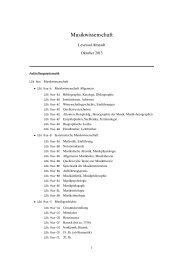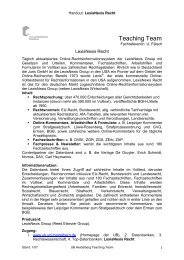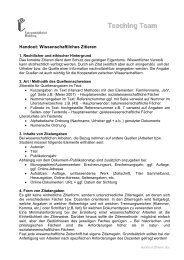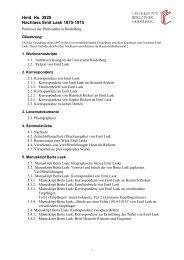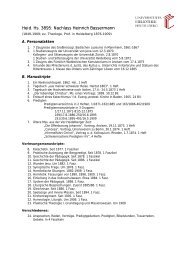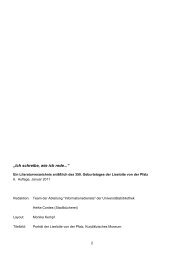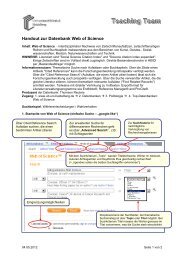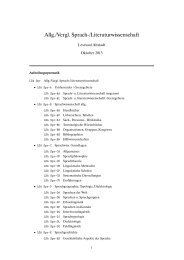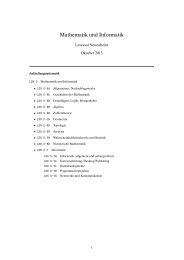Kommentiertes Vorlesungsverzeichnis Mathematik und Informatik
Kommentiertes Vorlesungsverzeichnis Mathematik und Informatik
Kommentiertes Vorlesungsverzeichnis Mathematik und Informatik
Erfolgreiche ePaper selbst erstellen
Machen Sie aus Ihren PDF Publikationen ein blätterbares Flipbook mit unserer einzigartigen Google optimierten e-Paper Software.
2.1. BACHELOR-VORLESUNGEN 13<br />
furcation theory.<br />
In the final part of the course we present some elements<br />
from Chaos Theory. We introduce the new ideas<br />
via the famous Lorentz System of ordinary differential<br />
equations.<br />
Throughout the course we make applications to models<br />
arising in various applied fields. For example, in<br />
the field of Mathematical Biology we consider models<br />
in population dynamics, the spread of infectious diseases,<br />
and predator-prey ecosystems. We make applications<br />
to Celestial Mechanics in the context of the<br />
two-body problem and other problems arising in newtonian<br />
central force systems. We introduce the phenomenon<br />
of periodic solutions and limit cycles by considering<br />
the Van der Pol oscillator from Electrical Circuits<br />
Theory.<br />
Literatur: M. Hirsch, S. Smale, and R. Devaney: Differential<br />
Equations, Dynamical Systems, and an Introduction<br />
to Chaos.<br />
Voraussetzungen: Linear Algebra, Multivariate<br />
Calculus<br />
Hyperlink: https://sites.google.com/site/evgeniovcharovteaching/<br />
Literaturliste: 90<br />
Ovcharov<br />
Übungen zu Ordinary Differential Equations<br />
Jäger<br />
Partielle Differentialgleichungen<br />
Modul: MC2<br />
Zeit: Di, Do 09:00-11:00<br />
Ort: INF 294, AM SR 214<br />
⊗<br />
? Anmeldung Leistungspunkte<br />
? Fortsetzung ? Themenvergabe<br />
Inhalt: Einführung in das Gebet der partiellen Differentialgleichungen<br />
an Hand dreier klassischer Beispiele<br />
sowie Gr<strong>und</strong>wissen über einen funktionalanalytischen<br />
Zugang.<br />
I. Die Potentialgleichung: F<strong>und</strong>amentallösung, Maximumprinzip,<br />
Perron-Verfahren, Newton-Potential<br />
II. Die Wärmeflussgleichung: Anfangswertproblem<br />
III. Die Wellengleichung: Wellengleichung in niederen<br />
Raumdimensionen, Cauchy-Problem<br />
IV. Die Hilbertraummethode bei elliptischen Randwertproblemen<br />
Literatur: J. Jost: Partielle Differentialgleichungen<br />
Voraussetzungen: Analysis I <strong>und</strong> II (MA1, MA2) ,<br />
Lineare Algebra I <strong>und</strong> II (MA4, MA5), Höhere Analysis<br />
(MA3)<br />
Bemerkungen: Vgl. Modul MC2 im Modulhandbuch<br />
des Bachelorstudiengangs <strong>Mathematik</strong><br />
http://www.mathematik.uni-heidelberg.de<br />
Ü<br />
V<br />
/bachelor.html<br />
Literaturliste: 103<br />
Jäger<br />
Übungen zu Partielle Differentialgleichungen<br />
Knüpfer<br />
Funktionalanalysis<br />
Modul: MC3<br />
Zeit: Di, Do 09:00-11:00<br />
Ort: INF 294, AM HS -104<br />
Inhalt:<br />
I. Metrische Räume <strong>und</strong> ihre Abbildungen: u.a. Vervollständigung,<br />
Satz von Baire, (relativ) kompakte<br />
Teilmengen <strong>und</strong> ihre Charakterisierung, Fortsetzbarkeit<br />
gleichmässig stetiger Abbildungen.<br />
II. Normierte Räume <strong>und</strong> ihre Abbildungen: inklusiv<br />
Banach-Räume, Dualräume, schwache Topologien,<br />
topologische Vektorräume, Beispiele von Funktionenräumen,<br />
Spektraltheorie kompakter Operatoren,<br />
mit den üblichen Sätzen (inklusiv Spektralsatz)<br />
III. Hilbert-Räume <strong>und</strong> ihre Abbildungen<br />
Literatur: W. Alt: Funktionalanalysis<br />
Voraussetzungen: Analysis I <strong>und</strong> II (MA1, MA2) ,<br />
Lineare Algebra I <strong>und</strong> II (MA4, MA5), Höhere Analysis<br />
(MA3)<br />
Bemerkungen: Vgl. Modul MC3 im Modulhandbuch<br />
des Bachelorstudiengangs <strong>Mathematik</strong><br />
/bachelor.html<br />
Literaturliste: 260<br />
http://www.mathematik.uni-heidelberg.de<br />
N.N.<br />
Übungen zu Funktionalanalysis<br />
Modul: MC3<br />
Rheinländer;Kondermann<br />
<strong>Mathematik</strong> für <strong>Informatik</strong>er 2<br />
Modul: IMI2<br />
Pflichtmodul: Bachelor <strong>Informatik</strong><br />
Zeit: Di, Fr 11:00-13:00<br />
Ort: INF 288, MathI HS 2<br />
⊗<br />
○ Anmeldung Leistungspunkte<br />
○ Fortsetzung ○ Themenvergabe<br />
Inhalt: Die Vorlesung <strong>Mathematik</strong> für <strong>Informatik</strong>er<br />
2 setzt die Vorlesung <strong>Mathematik</strong> für <strong>Informatik</strong>er 1<br />
aus dem Wintersemester 2012/13 fort. Sie richtet sich<br />
an <strong>Informatik</strong>-Studierende, welche nicht die Analysis<br />
Ü<br />
V<br />
Ü<br />
V



